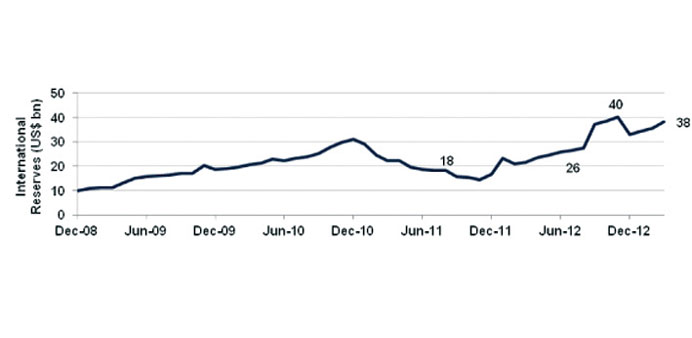Qatar’s international reserves have recorded a healthy $38bn in March on the back of a strong growth in foreign exchange receipts from rising exports, a new study has shown.
According to QNB, $5bn was added to the country’s international reserves in just three months up to March.
Qatar Central Bank’s international reserves have been steadily increasing since 2000 as foreign exchange receipts from exports grew. The pullback in reserves in 2011 was largely due to capital outflows for the purchase of foreign assets.
The recovery in reserves in 2012 occurred as the rate of investment outflows slowed, QNB said in its “Qatar monthly monitor”.
“We forecast international reserves to move up gradually in 2013-14, even though investments overseas remain strong,” QNB said.
QCB’s foreign exchange reserves that stood at $33.1bn in December, 2012 would have provided cover for some 16 months of imports, which was well above the IMF-suggested minimum of three months.
Meanwhile, lift off provided by foreign currency demand deposits with local banks strengthened Qatar’s domestic liquidity as broad money supply (M2) reached QR417bn in March, up 37.4% year-on-year, the report showed.
Money supply in March grew 2.1% month-on-month.
According to QNB, Qatar’s current account surplus has expanded, driven by strong export growth of 19% from 2008-12. Partially offsetting this increase, imports have grown at a rate of 5% during the same period and non-physical transfers abroad have grown.
Non-physical outflows increased by 27% from 2008-12, mainly owing to an increase in the repatriation of workers’ remittances and company profits as corporate and individual incomes have risen in line with Qatar’s rapid economic growth. Transportation services payments are also a significant outflow under the current account, mainly consisting of transport costs related to the export of hydrocarbons and imports of goods.
The report indicated that four major Asian countries, Japan, South Korea, India and China, remained the top export destinations for Qatar and accounted for more than 75% of the country’s exports.
Combined, they accounted for exports worth QR73.2bn ($20.1bn) in the third quarter of 2012, driven mainly by liquefied natural gas contracts.
Japan remained Qatar’s top destination with QR32bn ($8.8bn) in the third quarter of last year. South Korea accounted for about QR21.8bn ($6bn), India QR12bn ($3.3bn) and China QR7.28bn ($2bn).
The EEC accounted for most of Qatari imports and accounted for QR5.8bn ($1.7bn) in the third quarter.
The other major import sources for Qatar in the third quarter, 2012 were the US- QR2.5bn ($0.7bn), China QR1.09bn ($0.3bn), Japan QR1.45bn ($0.4bn) and the UAE QR2.9bn ($0.8bn).
Qatari exports to China are continuously rising and have increased by 85% y-o-y on the back of new LNG contracts.
According to QNB, the country’s exports to Japan have shown a 22.6% increase y-o-y, South Korea 24% y-o-y and India 3.7% y-o-y.
Outside of Asia, the major export destination for Qatar was the European Economic Community in the third quarter. EEC accounted for QR9.5bn ($2.6bn) Qatari exports in the third quarter of last year.
Qatar’s oil production averaged 720,000 barrels per day in April, which shows a decline of 1.6% y-o-y, believed to be because of Opec quota restrictions. The Qatari crude averaged $103.5 per barrel in April, which shows a decline of 2.2% y-o-y.

